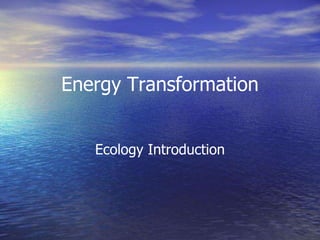Energy Transformation powerpoint.ppt.pptx
•Download as PPTX, PDF•
0 likes•7 views
energy
Report
Share
Report
Share

Recommended
More Related Content
Similar to Energy Transformation powerpoint.ppt.pptx
Similar to Energy Transformation powerpoint.ppt.pptx (20)
Basics of energy conversion and solar cell working

Basics of energy conversion and solar cell working
Recently uploaded
Recently uploaded (20)
Nanoparticles for the Treatment of Alzheimer’s Disease_102718.pptx

Nanoparticles for the Treatment of Alzheimer’s Disease_102718.pptx
Factor Causing low production and physiology of mamary Gland

Factor Causing low production and physiology of mamary Gland
MSC IV_Forensic medicine - Mechanical injuries.pdf

MSC IV_Forensic medicine - Mechanical injuries.pdf
Soil and Water Conservation Engineering (SWCE) is a specialized field of stud...

Soil and Water Conservation Engineering (SWCE) is a specialized field of stud...
Information science research with large language models: between science and ...

Information science research with large language models: between science and ...
X-rays from a Central “Exhaust Vent” of the Galactic Center Chimney

X-rays from a Central “Exhaust Vent” of the Galactic Center Chimney
SaffronCrocusGenomicsThessalonikiOnlineMay2024TalkOnline.pptx

SaffronCrocusGenomicsThessalonikiOnlineMay2024TalkOnline.pptx
Costs to heap leach gold ore tailings in Karamoja region of Uganda

Costs to heap leach gold ore tailings in Karamoja region of Uganda
Fun for mover student's book- English book for teaching.pdf

Fun for mover student's book- English book for teaching.pdf
Adaptive Restore algorithm & importance Monte Carlo

Adaptive Restore algorithm & importance Monte Carlo
Energy Transformation powerpoint.ppt.pptx
- 2. The Law of Conservation of Energy ●Energy is not created or destroyed, but can change form!
- 3. Energy comes in different forms ●Kinetic energy: The energy of motion/action ●Potential energy: is stored energy and the energy of position ●Thermal energy: Heat, the internal energy concerning the motion of molecules- temperature is the measure of thermal energy, the faster the molecules, the
- 4. Forms of energy cont… ●Chemical Energy is energy stored in the bonds of atoms and molecules. This includes energy stored in glucose (your food!) ●Electrical energy: created when electrons (a subatomic particle) move amongst different atoms to form an electrical charge- this includes lightening! ●Electrochemical Energy: Energy stored in batteries
- 5. Forms of energy cont… ●Electromagnetic energy/ Radiation: Light energy (i.e. from the sun!) Travels in waves ●Sound energy: Produced by sound waves ●Nuclear energy: Produced when the nuclei of atoms fuse (fusion occurring in the sun) or when the nuclei of atoms split (fission occurring in nuclear reactors)
- 6. Solar Energy ●Solar Energy is considered Radiation, in order to be useable, it must be captured by plants using photosynthesis. ●Radiation in not matter, but energy containing waves. Whereas matter is anything that contains mass, is made of atoms and takes up space.
- 7. Solar Energy ●Matter is recycled and energy is transferred! ●The original source of all energy in an ecosystem is the sun.
- 8. Energy Transfer ●Energy can be transferred from one organism to the next, however, not all energy is retained. ●Much energy is lost as heat. Only 10% of energy gets transferred from one trophic level to the next! (Rule of 10%)
- 9. Food Webs ●A food web shows the energy transfer from one trophic level to the next as it flows through an ecosystem from producers to consumers to decomposers. ●The highest level consumers in the food web contain the least energy and the fewest individuals. ●Whereas the producers contain the most energy and the largest number of individual organisms.
- 10. Nature’s Balance ●Due to the balance of an ecosystem, if producers or decomposers are removed, the ecosystem will collapse. If any organism is removed it will affect the other populations.